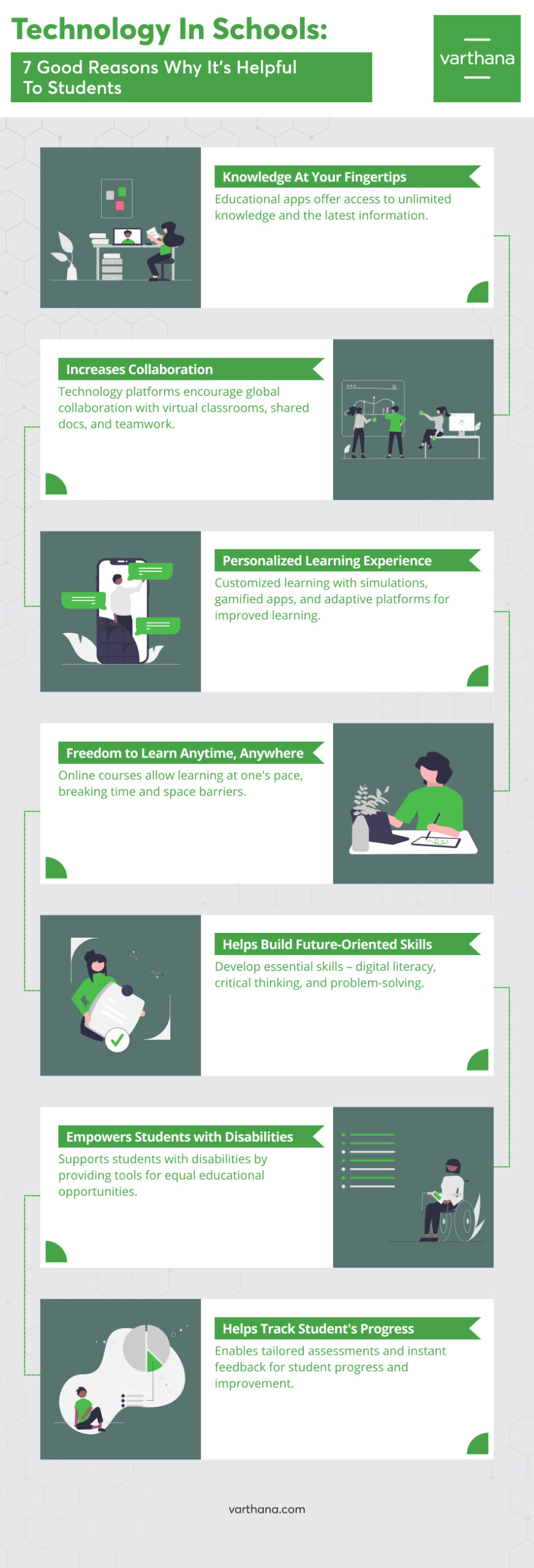
Table of Contents
Introduction
Imagine a classroom where technology in education has made learning more engaging—76% of students find lessons more interesting, and 90% of teachers can assess understanding more accurately. These aren’t just assumptions but real results from studies.
The importance of technology in education lies in its ability to provide students with vast information, encourage collaboration, and offer flexible learning options. From simulations to educational apps, digital tools have transformed traditional classrooms. Let’s explore seven key benefits of technology in education and how the impact of technology on education is shaping students’ learning experiences.

7 Key Benefits of Technology in Education for Students
Technology in education has made learning more engaging, accessible, and flexible. From accessing vast knowledge online to interactive lessons and real-time collaboration, students today have more opportunities than ever before. Here are the key benefits of technology in education and how it is shaping the future of learning.
1. Easy Access to Knowledge
With the internet and digital platforms, students can explore any topic anytime. Websites like Khan Academy offer free courses, helping students understand complex subjects better. This availability of resources strengthens research skills and proves the importance of technology in education in expanding knowledge beyond textbooks.
2. Learning Together from Anywhere
Collaboration is no longer limited to the classroom. Tools like Google Classroom allow students to work on group projects, share ideas, and receive instant feedback, no matter where they are. This ability to connect instantly showcases the impact of technology on education in making learning more interactive and connected.
Also Read: Simple guidelines to improve teaching quality and effectiveness in the classroom
3. Making Learning More Engaging
Traditional teaching methods can sometimes feel monotonous, but technology for students brings learning to life. Interactive simulations and gamified tools make subjects more interesting. For example, a 2017 study on the digital game “Decimal Point” found that students who played it learned better than those using traditional methods, proving that innovative ideas in technology for students can lead to better understanding and retention.
4. Learning at Your Own Speed
Not every student learns the same way or at the same pace. With online platforms like Coursera, students can study at their convenience, pausing and replaying lessons as needed. This flexibility is especially beneficial for students with disabilities, busy schedules, or those living in remote areas. Technology in education ensures that learning is not restricted to a fixed time or place.
5. Preparing for the Future
The world is becoming more digital, and students need to keep up. Developing problem-solving skills, digital literacy, and critical thinking is crucial for future careers. Reports predict that spending on education technology will cross $342 billion by 2025, proving that technology in education is not just an option but a necessity for future success.
6. Making Education Inclusive
For students with disabilities, technology in education offers life-changing support. Tools like speech recognition and screen-reading software help them learn effectively. For instance, visually impaired students can use JAWS screen reader software to access online classes, making learning more inclusive and accessible to everyone.
7. Simplifying Teaching for Better Learning
Teachers are also benefiting from technology in education. Online tests, automated grading, and instant feedback allow educators to track student progress efficiently. A study found that 45% of public schools actively use technology in their teaching, proving its importance in modern education.
The advantages of technology in education go beyond just making lessons digital. It empowers students, simplifies teaching, and makes learning more inclusive and engaging. As education continues to evolve, technology for students will remain at the heart of this transformation, creating a smarter and more connected future for all.
Tips to Effectively Implement Technology in Classrooms
Using technology in the classroom, when done correctly, can enhance the student’s learning experience and increase their interest in learning. Here are some examples with practical applications:
1. Conduct Virtual Field Trips
You can take your students on virtual field trips using VR or Internet resources. For example, students can travel using Google Earth to historical or geographical landmarks and learn about them, all from the comfort of the classroom.
2. Integrate Social Media for Collaboration
Use social media for collaboration and communication. Setting up a Facebook group just for the class or creating a specific hashtag for the class on X may encourage students to discuss, exchange materials, and participate in class activities virtually.
3. Utilize Digital Mind Mapping Tools
Platforms such as MindMeister allow students to brainstorm ideas effortlessly during sessions. These platforms help students visualize their ideas, broaden their thinking, and assist them in grasping complicated ideas.
4. Implement Interactive Whiteboards
Interactive whiteboards enhance the learning process by enabling multimedia content and lessons to be annotated. Tools like SMART Boards support multi-faceted student engagement and provide an interactive experience during lessons.
5. Assign Collaborative Projects Using Cloud-Based Platforms
Cloud programs such as Google Workspace allow students to work more effectively together on group projects. Using Google Services such as Docs and Slides, students can simultaneously work on the same document from different locations.
6. Incorporate Educational Videos
To engage learners who understand better visually, educational videos should be utilized to help support concepts. YouTube is full of channels devoted to education, like the Khan Academy, which covers numerous subjects and topics in depth.
7. Encourage Blogging for Reflection
Students should be able to create blogs to reflect on their learning as well as assess their peers’ work, and students’ work can be published on a classroom wall. Edublogs are one example of such a tool that students can use in a safe environment to hone their writing and digital skills.
8. Implement Classroom Management Apps
Use ClassDojo to manage and monitor student behaviour, communicate with parents, and capture and share moments from class. These instruments assist in fostering a positive classroom culture and communication with all stakeholders.
When combining these technological techniques, teachers can prepare a more engaged and collaborative learning environment for the students in a way that makes them ready for the digital world.
How Can You Make Educational Technology Work for You?
By thoughtfully integrating and continually updating educational Technology, you can create a more engaging and effective learning environment that benefits students and your fellow educators.
When used wisely, technology in education makes learning more engaging and teaching more effective. It helps students access information easily and allows teachers to simplify complex concepts. To make the most of it, follow these steps:
1. Identify What You Need
Before using any tool, understand the challenges in your classroom. Whether it’s improving engagement or simplifying explanations, knowing your needs helps you select the right technology.
2. Set Clear Goals
Technology should solve a problem, not create one. Decide whether you want to enhance interaction, make learning flexible, or help students grasp difficult subjects better.
3. Select the Right Tools
Not all digital tools are helpful. Choose ones that align with your goals and are easy for both students and teachers to use.
4. Learn How to Use Them
Even the finest tools fall short if users lack the knowledge to utilize them. Adequate training guarantees that both students and educators can maximize the benefits of technology in education.
Varthana assists affordable private schools in adopting digital technology by supplying crucial resources and support. In addition to providing access to tools, Varthana helps school leaders through teacher training initiatives and specialized webinars that focus on current educational trends and actionable methods for incorporating technology into the classroom. This ensures that teachers are prepared to leverage digital innovations, ultimately improving student learning results.
5. Integrate Without Disrupting
Technology in education should support existing teaching methods, not replace them completely. A balanced approach improves learning without losing personal interactions.
6. Monitor and Improve
Keep track of how well the technology is working. Get feedback from students and teachers to make adjustments and maximize its impact.
7. Encourage Collaboration
Use digital tools to improve teamwork, communication, and discussions between students and teachers, making learning more interactive.
8. Stay Updated
New developments in education technology continue to emerge. Keeping up with the latest innovations helps create a better learning experience.
By thoughtfully selecting and using technology in education, classrooms become more engaging, effective, and future-ready.
Conclusion
Technology has intervened making learning more engaging, flexible, and accessible. It provides a way to simply foster the learning of new things with collaboration and better work preparation for future careers. With the right approach, schools can create a learning environment that encourages student motivation and achievement.
Various schools, however, face challenges in providing their classrooms with contemporary amenities. Varthana assists affordable private schools with employing technology in education, refurbishing infrastructure, and offering better teaching tactics. With these developments, we provide schools with the step toward an all-round approach to technology-aided learning at all levels. Want to upgrade your school and improve the quality of education? Reach out to Varthana now!
FAQs
1. How can we take advantage of technology?
We can take advantage of technology by using it to simplify tasks, enhance learning, improve communication, and access information quickly. Embracing new tools and staying updated with technological trends can help us make the most of its benefits.
2. Why is technology important in education?
Technology is important in education because it makes learning more engaging, accessible, and personalized. It helps students and teachers connect with resources and tools that can improve understanding and make the educational process more efficient and effective.
3. How can you benefit from using technology in education?
Embracing technology in education offers personalized learning, improved accessibility, and enhanced engagement, providing you with a more interactive and efficient learning experience.
4. What is the role of technology in teaching and learning?
Technology plays a pivotal role in teaching and learning by facilitating innovative instructional methods, fostering collaboration, and preparing students for the digital age.
5. Is technology good or bad for students?
Technology can be beneficial for students when used wisely, offering access to a wealth of information. Varthana’s school loans empower school leaders by providing essential infrastructure, digital classrooms, and other facilities, ensuring a conducive learning environment for students.
Similar Articles Related to Technology in Education
- 10 ways technology will impact the Indian education system in the next 5 Years
- 5 Ways You Can Build Up Tech-Focused Entrepreneurial Skills in Students
- Preparing for the Future: Features of Career and Technical Education (CTE) Programs
- 6 Educational Technology Trends That Will Have A Major Impact In 2024





Social